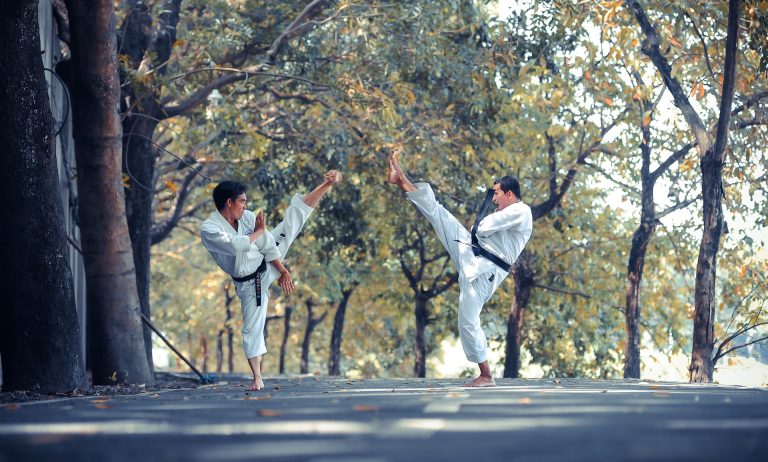Agility Exercise Sequences for More Effective Karate Training
Karate is a martial art that requires speed, accuracy, and agility. For any karate practitioner, agility training is just as important as strength training. Agility exercises not only improve your ability to move quickly and change direction, it also helps to prevent injuries in the long run. In this article, we will outline some agility exercise sequences that can help you achieve more effective karate training.
Warm-Up Exercise
Before you start any agility exercises, it’s important to perform a proper warm-up routine. Start with a light jog or some jumping jacks to get your heart rate up. Follow this up with some dynamic stretching exercises such as leg swings, high knees, and lunges. This will help to loosen up your muscles and increase blood flow to the working muscles.
Agility Exercise Sequence #1: The Zig Zag Run
This exercise is great for improving your lateral movement and change of direction. Start by placing cones in a zig-zag pattern, about one yard apart from each other. Begin at one end and sprint diagonally to the first cone, then immediately switch direction and sprint to the next cone. Keep your feet low to the ground and focus on quick, sharp movements. Repeat this exercise for a distance of 20 to 30 yards.
Agility Exercise Sequence #2: The Dot Drill
The dot drill is a classic agility exercise that improves coordination, balance, and footwork. Start by marking out a grid of dots, about two feet apart from each other. The dots should form a square, with four dots on each side. Then, begin hopping from dot to dot in a predetermined pattern. You can use any pattern you like, but a simple one to start with is to hop twice on the first dot, then hop once on the second dot, then repeat for the remaining dots. Try to perform the drill as quickly as possible while maintaining proper form.
Agility Exercise Sequence #3: The Speed Ladder
The speed ladder is a versatile agility tool that can be used for a variety of exercises. Start by laying the ladder on the ground and facing it. Begin by stepping into the first box with one foot, then quickly follow with the other foot. Then, step outside of the second box with the first foot, then follow with the other foot. Continue this pattern down the ladder, moving as quickly as possible. You can also perform variations of the exercise such as lateral shuffles, single leg hops or jumping jacks.
Conclusion
Incorporating agility training into your karate routine can greatly enhance your performance and reduce the risk of injury. The three agility exercise sequences outlined above are just a few examples of many exercises that you can incorporate into your training routine. Remember to always start with a proper warm-up routine, and to focus on maintaining proper form while performing each exercise. With consistent training and practice, your agility will improve over time, leading to more effective karate training.
Agility Exercise Sequences for More Effective Karate Training
Are you looking to improve your karate skills? One way to enhance your performance is by incorporating agility exercises into your training routine. Agility exercises help to develop speed, coordination, flexibility, and balance, which are all essential attributes for karate practitioners. In this post, we will answer some frequently asked questions about agility exercise sequences for more effective karate training.
What are Agility Exercises?
Agility exercises are physical activities that require quick movements and changes in direction. These exercises help to develop our neuromuscular system, which controls our musculoskeletal movements. Agility exercises improve the communication between the brain and the muscles, making movements more efficient and effective.
Why Should Karate Practitioners Include Agility Exercises in their Training?
Karate requires quick reflexes, rapid movements, and quick changes in direction. Agility exercises help karate practitioners to develop these skills, which are essential for effective karate training. Agility exercises also help to improve balance, flexibility, and coordination, helping to prevent injuries and improve overall performance.
What are Some Effective Agility Exercises for Karate Practitioners?
There are several agility exercises that karate practitioners can incorporate into their training routine. Here are some effective agility exercises for karate training:
Shuttle Runs:
Shuttle runs involve running back and forth between two points, touching the ground each time you reach a point. This exercise helps to improve speed, agility, and quickness.
Cone Drills:
Cone drills involve setting up cones in a pattern and running around them in a specific sequence. This exercise helps to improve agility, balance, and coordination.
Ladder Drills:
Ladder drills involve running through a ladder on the ground, stepping in and out of each square. This exercise helps to improve footwork, agility, and coordination.
Bounding Exercises:
Bounding exercises involve hopping or jumping with both feet or one foot over a distance. This exercise helps to improve leg strength, power, and explosiveness.
Jump Rope:
Jump rope involves skipping rope while jumping. This exercise helps to improve footwork, agility, and coordination.
How Often Should Agility Exercises be Incorporated into Karate Training?
Agility exercises should be incorporated into karate training at least two to three times a week. It’s essential to vary the routine, alternating between different exercises to keep it engaging and effective.
What are the Benefits of Agility Exercises for Karate Practitioners?
Agility exercises offer several benefits for karate practitioners. These include:
– Improved speed and agility
– Enhanced coordination and balance
– Improved neuromuscular control
– Reduced risk of injuries
– Improved overall performance
Conclusion
Agility exercises are a great addition to any karate training routine. These exercises help to develop speed, agility, coordination, and balance, all essential skills for effective karate training. By incorporating agility exercises into your training routine, you can improve your overall performance and reduce the risk of injuries. So, add some agility exercises to your training and see the improvement yourself.
Inhaltsverzeichnis





